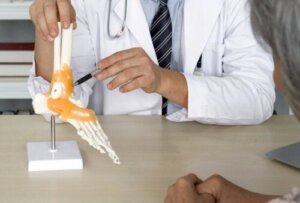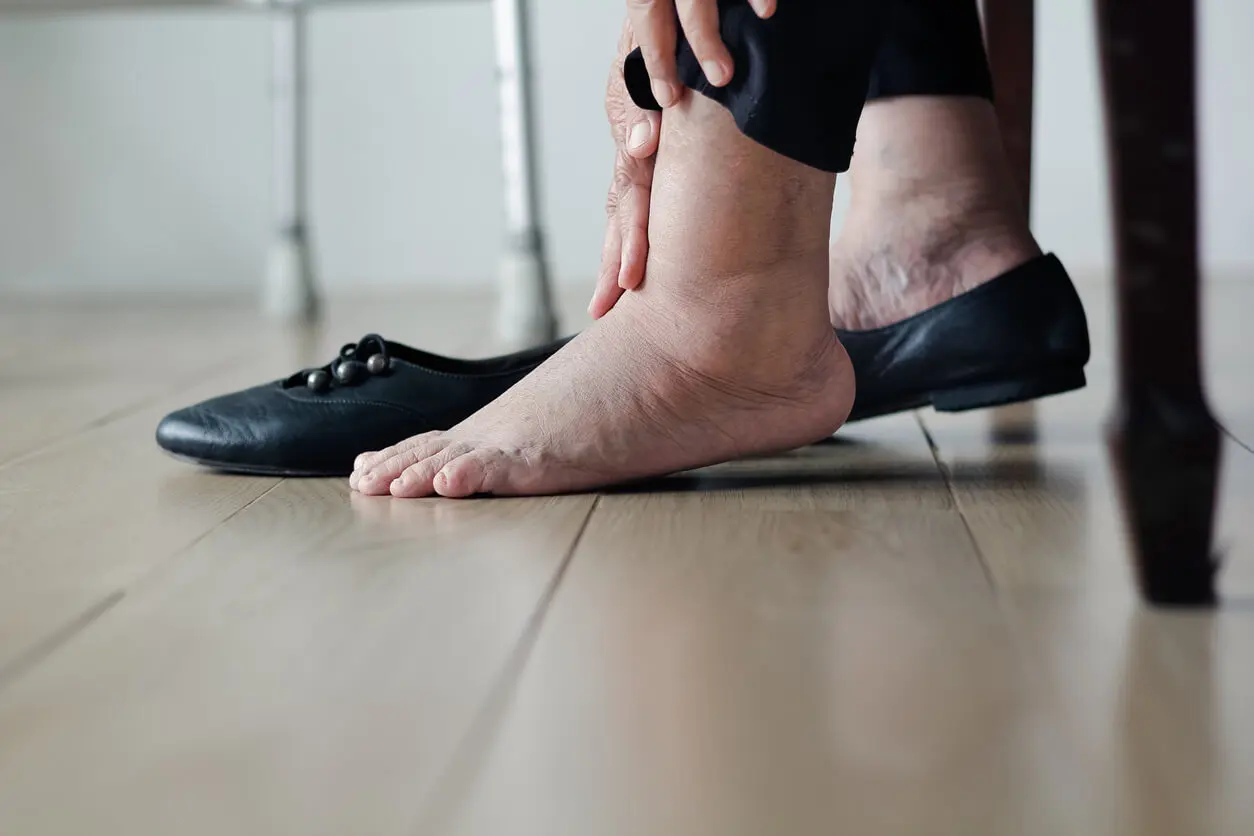What is Foot Arthrodesis?


Written and verified by the doctor Mariel Mendoza
Arthrodesis of the foot is a surgical procedure in which the two bony pieces that make up the joint of the foot are fused or permanently fixed. The aim is to relieve pain or correct a deformity of the limb.
The latter can be caused by multiple origins:
- Chronic inflammatory processes
- Degenerative diseases
- Congenital defects
- Bone infections
- Injuries
Fractures with poor healing process, rheumatoid arthritis, and infections are the main causes of deformity and pain in this anatomical region.
For the particular case of the ankle, a choice must often be made between a joint prosthesis or an arthrodesis. However, the second option remains a priority because it presents more predictable results. A surgeon usually has more confidence in it, since complications are fewer.
We think you may also liket to read this article: 24 Common Injuries in Dancers
Techniques for foot arthrodesis
This surgery is performed when non-surgical methods to correct the problem have been exhausted.
Overall, arthrodesis is performed in an operating room under general or spinal anesthesia. Two different techniques can be used:
- Open: A long incision is made and the joint can be visualized directly. This surgery is reserved for cases of major deformities that require a lot of maneuvering by the physician.
- Arthroscopic: An arthroscope is used, which is an endoscope that allows visualization of the joint with a very small camera. Through small incisions, the instrument is introduced to view the magnified detail on a monitor, giving the orthopedic surgeon direct access.
Apart from the approaches, one of the techniques that’s frequently used is the so-called triple arthrodesis. Its name is due to the fact that 3 joints are fused. With good application in children, the results of this variant persist for decades with pain relief for patients.

How is the joint fused?
Prior to surgery, a tourniquet will be placed around the thigh to reduce circulation. This step is required because the surrounding area of the foot should not receive too much blood at the time of the surgical fusion. However, this will not cause deleterious future effects on the tissue.
The technique of foot arthrodesis involves resection of the articular cartilage of the joint. This allows direct contact between the two bone surfaces. Some method is then used to hold the hard tissues in place.
The cartilage protects the joint by acting as a shock absorber. The resection of the articular cartilage is nothing more than the removal of the cartilage, the synovial membrane, and its capsule.
To secure the two bones together in a foot arthrodesis there are different elements. They can be screws (long or short), plates, or steel rods. Even bone grafts are often used nowadays.
Bone grafts reduce the risk of nonunion. An autograft can be used when a bone is taken from another area of the skeleton of the same individual and placed in the desired location, or an allograft can be used, in which bone from another individual is used – i.e. bone is transplanted from one person to another.
The fixations will be internal if we are talking about screws, plates, or fixators. However, there will also be options with external fixation techniques, such as casts.
Recovery after foot arthrodesis
After foot arthrodesis, it takes 8 to 16 weeks for the joints to fuse completely. Afterward, rehabilitation treatment with physical therapy will be required.
Oral medication is used for postoperative pain management. In addition, the surgical wounds, however small they may be, should be dressed and periodic follow-up X-rays should be taken.
After surgery, the lower leg should be elevated and supported with a rigid cast.
In addition, special footwear should be worn until the bone is fused. Subsequently, it’s likely to require the use of custom or athletic footwear for a further 6 to 8 weeks.
Full mobility of the foot will not be lost.
Physical activities, such as walking or running, will be possible because it is compensated by the other joints. However, during the first 4 weeks, the limbs should not be loaded. Ideally, crutches should be used during this time.
Like this article? We think you may also like to read: Butterfly Skin: Extreme Skin Fragility
After the surgery
After foot arthrodesis, infection or bleeding may occur at the surgical site. Nerve damage to the area may also occur. Both of these complications are just as common with the open technique as with the arthroscopic technique.
In addition, the joint may fail to solidify. This lack of adequate internal healing occurs at least 7% of the time. However, there are risk factors that can increase these chances of poor solidification to 25% or more, such as cigarette smoking.
Obesity is also a risk factor for delayed fusion.
Final alignment may also be unsatisfactory. Pain or difficulty walking will then persist after surgery. These cases may require reoperation a posteriori.
It’s not uncommon for one limb to be shorter than the other. Fortunately, this can be remedied with special footwear.

The results of this surgery are satisfactory in most patients
After foot arthrodesis, results include improvement of pain and reduction of deformity in up to 80% of patients. Some individuals, however, will require the use of custom-made footwear.
Although the joint can no longer be mobilized in a natural way, it’s fixed in a functional position to allow the limb to continue to have some mobility. Thus, the approach is useful in cases where there are no other treatment alternatives, but the patient has continuous active use of the limb in question.
Especially in children, surgical correction remains paramount for clinical conditions that could alter the quality of life of patients in adulthood. While there are several disorders that improve with orthopedics, surgery is unavoidable in severe cases. For them, arthrodesis is a big relief.
All cited sources were thoroughly reviewed by our team to ensure their quality, reliability, currency, and validity. The bibliography of this article was considered reliable and of academic or scientific accuracy.
- Alcalá J, Ahumada J, Morilla M. Artrodesis digital. Revisión histórica y sistemas tradicionales de fijación. Revista Española de Podología. 2013, XXIV (2). Disponible en https://www.revesppod.com/Documentos/ArticulosNew/X0210123813502938.pdf.
- American Academy of Orthopaedic Surgeons. Arthritis of the foot and ankle: arthrodesis. American Academy of Orthopaedic Surgeons website. Disponible en: http://orthoinfo.aaos.org/topic.cfm?topic=A00209.
- Catanzariti AR, Dix BT, Richardson PE, Mendicino RW. Triple arthrodesis for adult acquired flatfoot. Clin Podiatr Med Surg. 2014 Jul;31(3):415-33.
- del Vecchio, Jorge Javier, and Mauricio Esteban Ghioldi. “Capítulo 6.9: Artrodesis subastragalina.”
- Painceira R, Painceira T, Cicchinelli L, Roca A. Tratamiento quirúrgico del pie plano adquirido del adulto. Caso Clínico. Eur J Pod 2019;5(2).
- Rabinovich, Remy V., Amgad M. Haleem, and S. Robert Rozbruch. “Complex ankle arthrodesis: review of the literature.” World journal of orthopedics 6.8 (2015): 602.
- Rungprai, Chamnanni, et al. “Outcomes and complications after open versus posterior arthroscopic subtalar arthrodesis in 121 patients.” JBJS 98.8 (2016): 636-646.
- Téllez, Patricia Parra, et al. “Apoyo precoz en la artrodesis de tobillo por incisiones mínimas. Experiencia en el Instituto Nacional de Rehabilitación.” Anales Médicos de la Asociación Médica del Centro Médico ABC 66.1 (2021): 6-12.
This text is provided for informational purposes only and does not replace consultation with a professional. If in doubt, consult your specialist.








